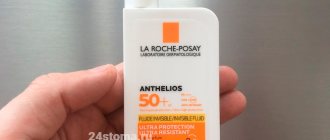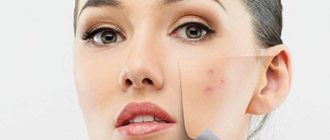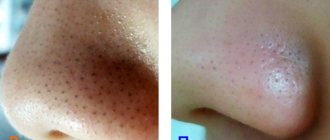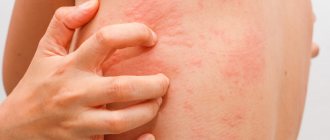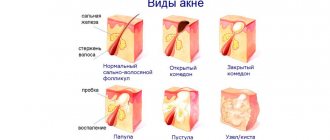The skin reflects the condition of the gastrointestinal tract. It is sensitive to pathological processes in the digestive system, which manifest themselves as dermatoses. One of the most common manifestations is acne. Acne can appear sporadically under the influence of passing factors - poor diet, alcohol intake, infectious disease. Sometimes the rash is observed constantly, if we are talking about chronic long-term disorders in the gastrointestinal tract. Intestinal microflora and acne is an issue that is being researched to this day, and several mechanisms of the skin response to gastrointestinal diseases are now known.
With acne, it is important not to mask the symptom with cosmetics, but to understand the causes. An integrated approach will help you quickly cope with cosmetic defects and improve your overall well-being.
How do acne appear?
The cause of acne may be dysbacteriosis - this is a condition in which there is a change in the balance of beneficial and opportunistic microorganisms towards the predominance of the latter. Beneficial microflora has many functions:
- participation in food digestion - processes of breakdown and absorption of beneficial micronutrients;
- participation in metabolic processes;
- synthesis of vitamins in the intestines;
- inhibition of the reproduction processes of pathogenic and opportunistic bacteria;
- removal of toxins and breakdown products;
- regulation of fecal excretion.
When there are fewer beneficial bacteria, pathogenic ones begin to actively multiply. This leads to disruptions in all of the above processes, which means a decrease in the synthesis of vitamins and a slowdown in the processes of natural bowel cleansing. As a result, intoxication begins, since decay products and harmful substances that are not removed from the intestines are absorbed into the bloodstream. There is a deterioration in general well-being and a decrease in defenses. The skin is part of the excretory system, so it takes on increased load. Natural reactions include peeling and the appearance of inflammatory elements.
Dysbacteriosis is often accompanied by impaired bowel movement. However, it is not the only cause of constipation. Difficulty with bowel movements can be associated with impaired intestinal motility, diet, stress, hemorrhoids, a sedentary or sedentary lifestyle and other factors. At the same time, the mechanism for the appearance of acne on the face with insufficient cleansing of the intestines is the same - intoxication with products that are not eliminated in a timely manner.
It is important to remember that the skin is an organ that is also inhabited by beneficial and harmful bacteria. Harmful are opportunistic microorganisms that do not cause inflammation until the balance is upset. When the intestinal microflora changes, the composition of bacteria on the surface of the skin also changes; it becomes more difficult for beneficial microorganisms to restrain the growth of opportunistic pathogens. In this regard, inflammation develops.
The causes of acne also include chronic diseases of the gastrointestinal tract, such as:
- gastritis;
- gastroduodenitis;
- gastroesophageal reflux disease;
- stomach ulcer;
- duodenal ulcer.
With such diseases, skin rashes occur on the face, scalp, arms, back, chest. Changes in the skin can be associated not only with processes of chronic poisoning - processes of a metabolic deficit manifest themselves through dry skin, impaired barrier functions, changes in the production of sebum (sebum), and therefore are accompanied by a high risk of acne.
Liver disease is a common cause of acne. The liver is the main filter of the body, and pathological processes lead to the fact that it cannot cope with the neutralization of toxic substances. As a result, the body's excretory systems, including the skin, suffer. Despite the fact that many diseases of the liver and gallbladder manifest themselves specifically, for example, yellowness of the skin, there are also nonspecific symptoms: acne, redness and peeling of certain areas, excessive sebum production.
Acne is a chronic inflammatory disease of the sebaceous glands. Common causes of acne among all pathologies of the digestive system are functional disorders of the gastrointestinal tract, which are accompanied by constipation and gastroesophageal reflux. Some studies have linked acne to bacterial overgrowth. It, in turn, may be a consequence of previous operations, impaired intestinal motility, or lack of stomach acid production.
Impaired permeability of the intestinal wall affects the spread and severity of acne. Nutrition also plays an important role in the formation of acne: a high content of fats and carbohydrates in food provokes a decrease in the number of bifidobacteria, an increase in intestinal permeability and an inflammatory response of the skin. That is why dermatologists recommend following a healthy diet to reduce such manifestations and the amount of inflammatory elements.
The gut-skin connection
Good skin is a sign of a healthy gut, and there is a scientific explanation for this.
The skin and intestines are not only the human organs with the largest surface area and densest microbial populations, they also develop from the same embryonic layer. These two organs, with their extensive networks of nerves and blood vessels, are also connected through the immune system.
It is likely that the immune system plays a special role in setting up the connection between the intestines and the skin. The intestinal flora, which weighs a total of one to two kilograms, “pulls the strings”, constantly interacting with immune cells to trigger the production of antibodies. It strengthens the immune system, benefiting both the skin and intestines.
The gut flora is in some ways a powerful chemical laboratory that produces many different substances, including key materials for skin health such as hyaluronic acid and biotin, in addition to substances that support the gut's ability to digest and process food. Ultimately, it is this “cocktail” of substances in the intestines that affects the nervous system, which, among other things, affects blood circulation in the skin.
Diagnostic features
Before you start taking colon cleansing medications, it is important to understand the causes of acne. If you feel discomfort and notice problems with digestion, it is advisable to visit a therapist or gastroenterologist. Treatment of the underlying disease can significantly improve the condition of the skin.
Diagnosis of the gastrointestinal tract condition is carried out using different methods:
- Ultrasound of the abdominal organs;
- gastroscopy;
- probing and microscopic examination of bile;
- colonoscopy;
- laboratory tests: microflora studies, coprogram, general blood tests, urine tests, etc.
Based on the examination, the doctor makes an accurate diagnosis and develops a treatment plan.
Drugs and their action
The most effective way to restore microflora and get rid of dysbiosis is to use drugs from the group of probiotics. Manufacturers offer medicines in different forms:
- capsules;
- pills;
- powder;
- drops;
- solution.
The dosage form is selected by the doctor depending on the age of the patient. Children and elderly people who have difficulty swallowing tablets are prescribed a solution or powder for its preparation. At the age of 0-3 years, it is easier to give probiotic drops to a child. For everyone else, capsules or tablets are recommended.
Anti-dysbacteriosis medications are medications that can be purchased without a doctor's prescription. But self-medication is not recommended; only a specialist can tell you which type is best to take.
Probiotics usually contain 1-2 types of bacteria that restore mucous membranes well. Usually these are lacto- and bifidobacteria. They are normal inhabitants of the intestines that help improve microbial balance. The mechanism of action of this therapeutic group is associated with suppression of the growth of pathogenic flora. Lactic acid bacteria compete for receptors on the mucosal epithelium and nutrients. They secrete lactic acid and cytokines, which have an inhibitory effect on pathogens.
Preparations from the group of prebiotics help to effectively cure dysbiosis. These are medications that belong to the group of dietary fibers: inulin and lactulose, as well as drugs based on them.
They are not broken down by digestive enzymes and enter unchanged into the large intestine, where they become a nutrient substrate for lacto- and bifidobacteria. Therefore, microbes multiply well, increase the volume of bacterial mass, and restore the intestinal wall. To make the treatment as effective as possible, it is recommended to take prebiotics and probiotics at the same time.
Treatment of dysbiosis is not contraindicated in case of concomitant pathologies of the digestive tract. Probiotics are not harmful to patients with stomach ulcers, liver disease, or gallbladder disease. And in some cases they will speed up recovery.
In advanced cases of intestinal dysbiosis and when the symptoms of dyspepsia are too painful, medications from the group of enzymes can help. They should be selected by a doctor, depending on the type of digestive disorder. These medications must be taken daily before meals.
It’s hard to say how long it will take to treat dysbacteriosis. In some cases, this can last for several weeks, and in advanced cases – several months.
Treatment methods
If acne is only a consequence of dysfunction of the digestive system, the doctor will prescribe therapy for the underlying disease. Both specific drugs and symptomatic therapy may be required. For chronic constipation, a specialist will prescribe laxatives.
A therapeutic diet is required. It is important to adhere to a healthy diet, limiting intake of foods rich in carbohydrates and fats, as well as dairy products. Studies show that in functional disorders of the gastrointestinal tract associated with dysbiosis, probiotics and prebiotics demonstrate quite high effectiveness. They allow you to restore the normal balance of microflora after intestinal cleansing measures.
In some cases, colon hydrotherapy may be recommended in a clinic setting. This is intestinal lavage using a stream of physiological fluid. There are two ways to carry out the procedure: underwater rinsing, irrigation according to the Lensky method. As a result, it is possible to remove toxic substances, stagnant feces and improve overall well-being.
Underwater washing involves the use of a special apparatus. The procedure is carried out in a bath. Water heated to 37 °C is gradually supplied to the intestines. Feces are removed using a special suction device. Complete cleansing of the body requires several sessions.
Irrigation according to Lensky involves inserting a probe into the anus. The other end of the tube is located in a vessel with irrigating liquid. Water flows out through a special tube. The procedure takes about half an hour, it is recommended to repeat it after 2 days.
It is important to remember that both home cleansing (enemas, laxatives) and procedures in the clinic must be agreed upon with the attending physician. Such measures are necessary for patients suffering from constipation and other disorders. However, they also have contraindications.
Symptoms of dysbiosis
There are no strict symptoms that most likely indicate dysbiosis. Manifestations of pathology often do not correspond to the severity of the disorders. The most common symptom is indigestion such as intestinal dyspepsia. It manifests itself with the following symptoms:
- rumbling in the stomach;
- flatulence, increased gas formation;
- bloating;
- stool disorders;
- the appearance of pathological impurities in the stool.
Increased gas formation at the initial stage occurs after a nutritional disorder. If on a certain day the diet included milk, legumes, a large amount of flour and sweets, the symptoms appear clearly.
Stool disorders are variable. Most often, dysbiosis manifests itself as diarrhea. It may be accompanied by cramps and abdominal pain. Sometimes unformed stool appears only once a day, so it does not meet the criterion of diarrhea.
Diarrhea may alternate with constipation. This process is observed in people who limit the amount of fiber and dietary fiber in their diet. This deprives the bacteria of essential nutrients and prevents them from retaining water in the intestinal lumen. Mucous pathological impurities in the stool and abdominal pain appear with advanced forms of dysbacteriosis.
Violation of the microflora composition leads to vitamin deficiency. If it is not compensated by nutrition or taking multivitamin preparations, symptoms of hypovitaminosis appear:
- the condition of hair and nails worsens;
- rashes appear on the skin;
- allergic reactions or food intolerance appear;
- fatigue increases, performance decreases;
- sleep is disturbed.
Intestinal microorganisms synthesize vitamin K, which is involved in blood clotting. With hypovitaminosis, the appearance of bruises and hematomas under the skin from slight mechanical impact becomes more frequent. With a stomach ulcer or minor injuries, the risk of prolonged bleeding increases.
In severe cases, dysbiosis, which is accompanied by diarrhea, leads to dehydration. Many patients experience weight loss.
Classification of antibiotics
All antibacterial agents can be divided into 5 categories according to their characteristics and range of application. Let's take a closer look at this classification:
Mechanism of action:
- Bactericidal - the active substances of the drugs completely destroy bacteria and viruses. After taking such strong drugs, all pathogenic microflora in the human body dies.
- Bacteriostatic – inhibits the growth or spread of viruses. Thus, the cells remain “alive” without forming pathogenic flora.

